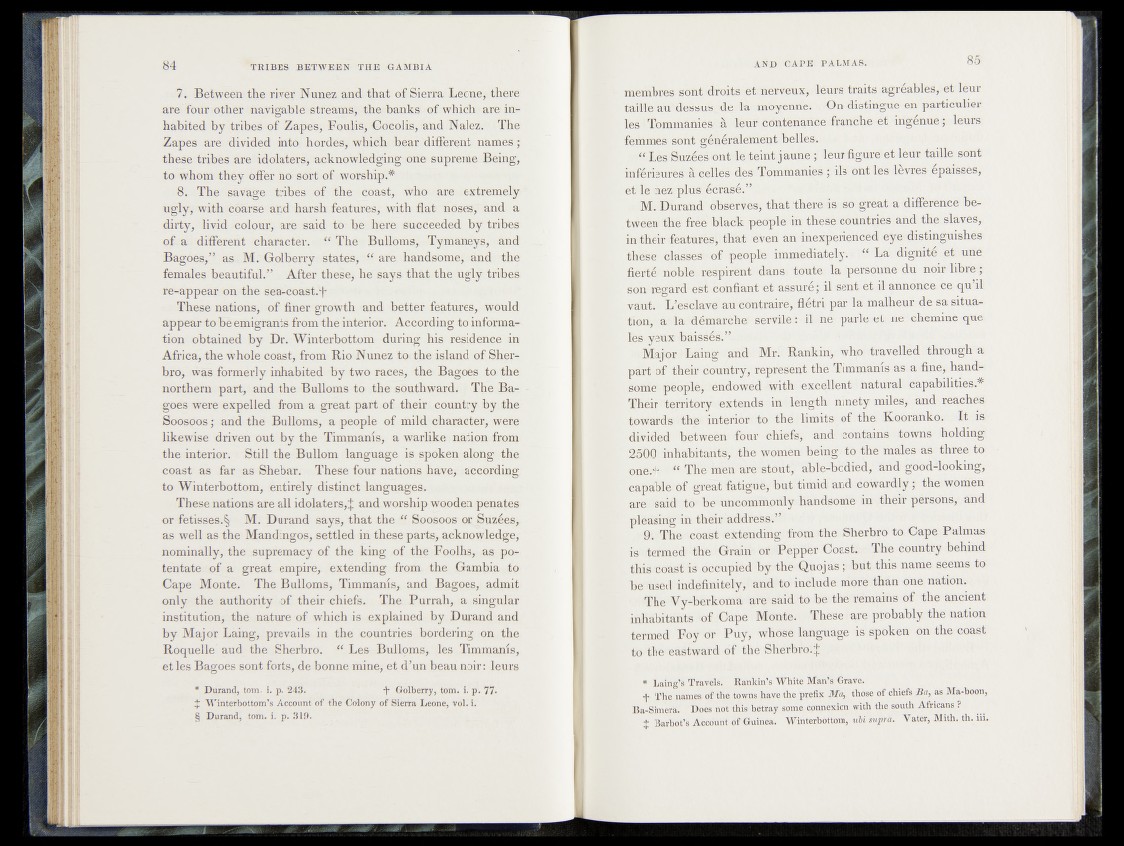
7. Between the rivei^ Nunez and that of Sierra Leone, there
are four other navigable streams, the banks of which are inhabited
by tribes of Zapes, Foulis, Cocolis, and Nalez. The
Zapes are divided into hordes,' which bear different names ;
these tribes are idolaters, acknowledging one supreme Being,
to whom they offer no sort of worship.*
8. The savage tribes of the coast, who are extremely
ugly, with coarse and harsh features, with flat'noseS; and a
dirty, livid colour, are said to be here succeeded by tribes
off a different character. “ The Bulloms, Tymaneys, and
Bagoes,” as M. Golberry states, u are handsome, and the
females beautiful.” After these, he says that the Ugly tribes
re-appear on the sea-coast.^'
These nations, of finer growth and better features, would
appearto Beemigrants from the interior. According to informal
tion obtained by Dr. Winterbottom during his residence in
Africa, the whole coast, from Rio Nunez torthe island ofSher-
bro, was formerly inhabited by two races, the Bagoes to the
northern part, and the Bulloms to the southward. The Bagoes
were expelled from a great part of their country by the
Soosoos; and the Bulloms, a people of mild character, were
likewise driven out by the Timmanis, a warlike nation from
the interior. Still the Bullom language is spoken along the
coast as far as Shebar. These four nations have, according,
to Winterbottom, entirely distinct languages.
These nations are all idolaters, J and worship wooden penates
or fetisses.§ M. Durand says, that the “ Soosoos ox Suzdes,.
as well as the Mandingos, settled in these parts, acknowledge,
nominally, the supremacy of the king of the Foolhs, as potentate
of a great empire, extending from the Gambia to
Cape Monte. The Bulloms, Timmanis, and Bagoes, admit
only the authority of their chiefs. The Purrah, a singular
institution, the nature of which is explained by Durand and
by Major Laing, prevails in the countries bordering on the
Roquelle aud the Sherbro. “ Lee Bulloms, les Timmanis,
etles Bagoes sont forts, de bonne mine, et d’un beau noir: leurs
* Durand, tom. i. p. 243. -j- Golberry, tom. i. p. 77*
% Winterbottom’s Account of the Colony of Sierra Leone, vol. i.
§ Durand, tom. i. p. 319.
membres sont droits ebnerveux, leurs traits agréables, et leur
taille au dessus^ de la . moyenne. On distingue en particulier
les Tommanies à leur contenance franche et ingénue ; leurs
femmes sont généralement belles.
“ Les Suzées ont le teint jaune ; leur figurent leur taille sont
inférieures à celles des Tommanies ; ils ont les lèvres épaisses,
et le nez plus écrasé. ”
M. Durand observes; that there is so great a difference between
the free black people in these countries and the slaves,
in their features, that even an inexperienced eye distinguishes
theses-classes; of people immediately.-: u La dignité et une
fierté noble respirent dans; toute la personne du noir libre ;
son rëgàrd est confiant et assuré; il sentiet-.il annonce ce qu’il
vaut. L’esclave au contraire, flétri par la malheur de sa:situation,
a la démarche servile .1 il .-ne parle, et ne chemine que
les yeux baissés.”-;;
Major Laing pnd Mr. Rankin, whp travelled through a
part of their country, represent thé Timmanis as a fine, handsome
people, endowed with excellent natural capabilities.*
Their 'territory extends in length ninety miles, and reaches
towards the interior to the limits of the Kooranko. It is
divided between four chiefs; and contains towns holding
2500 inhabitants, the women being - to the males as three to
one.f “ Thé men are ntout, able-bodied, and good-looking,
capable of gréât fatigue, but timid and cowardly ; the women
are said to be uncommonly handsome in their pérsons, and
pleasing in their address.’’
9. The coast extending from the Sherbro to Cape Palmas
is termed the Grain or Pepper Coast. The country behind
this coast is occupied by the Quojas ; blit this name seems to
be used indefinitely, and to include more than one nation.
The Vy-berkoma are said to be the remains of the ancient
inhabitants of Cape Monte. These are probably the nation
termed Foy or Puy, whose language is spoken on the coast
to the eastward of the Sherbro.£
* Laing’s Travels. Rankin’s White Man’s Grave.
jft The names of the towns have the prefix Ma, those of chiefs Ba, as Ma-boon,
Ba-Simefa. Does not this betray some connexion with the south Africans ?
$ Barbot’s Account of Guinea. Winterbottom, ubi supra. Vater, Mith. th. iii.